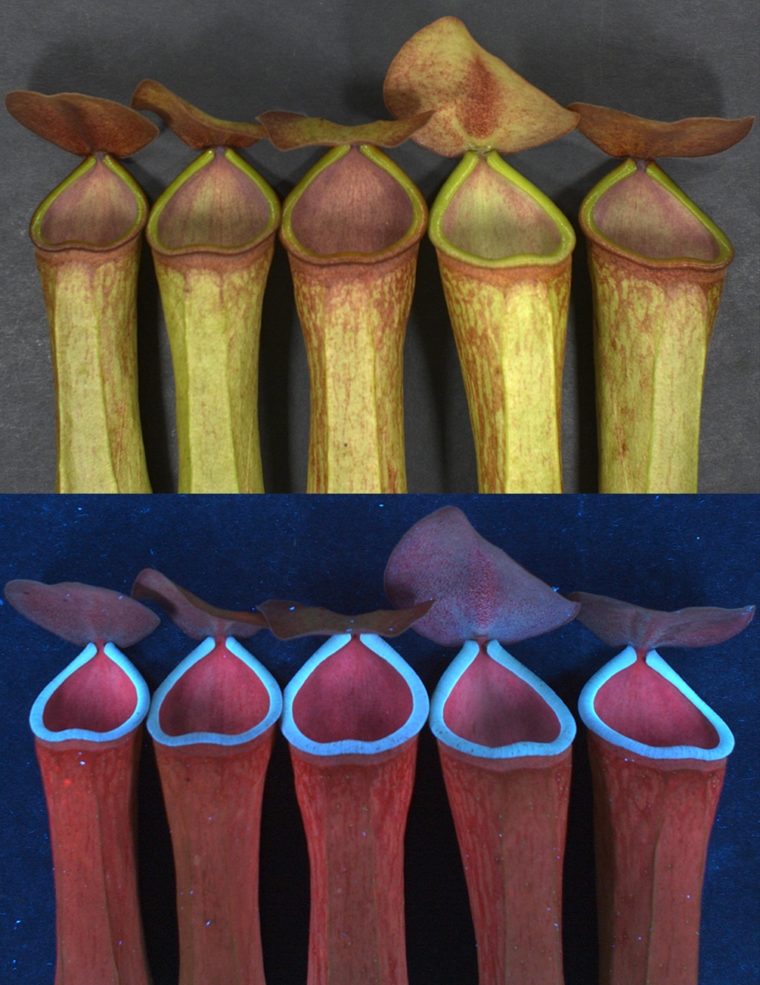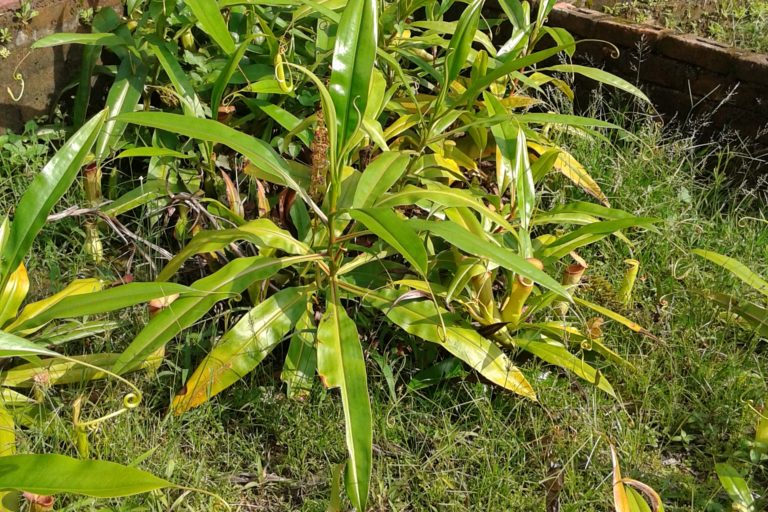- Pitcher plants are carnivorous plants that attract, kill and digest insects.
- Found mainly in the state of Meghalaya, India’s only pitcher plant species Nepenthes khasiana is endangered, facing threats from mining, shifting cultivation, and excessive collection, among others.
- N. khasiana is distributed in the Garo, Khasi, and Jaintia Hills. According to a study, the species marks the migration of the tropical pitcher plant genus Nepenthes into Southeast Asia.
- To conserve this species, methods such as tissue culture, micropropagation and germplasm preservation have been carried out primarily by government institutions. Villagers and students have been involved in various conservation initiatives.
High up in the majestic hills of India’s northeastern state of Meghalaya lies an elusive and unusual carnivore: a pitcher plant. The species is known popularly as ‘monkey cups’ because the animals were observed drinking rainwater from these tropical pitchers.
Over the past few decades, wild populations of the species have been declining due to threats from human activities, mainly extensive mining, shifting cultivation, and excessive collection. While various initiatives have been implemented to conserve the plant, success hinges on the efforts of local communities.
Pitcher plants are carnivorous plants that attract, kill and digest insects. The plants have evolved modified leaves consisting of jug-like pitchers, which function as pitfall traps that ‘hunt’ prey, mainly insects that curiously approach the pitcher rims and end up falling inside. Often unable to escape the slippery inner walls and sticky fluid inside the pitcher, the unfortunate victims die and enzymes at the bottom of the pitcher digest them to release nutrients needed by the plant.
India’s only known pitcher plant species Nepenthes khasiana Hook. f., is an evergreen shrub considered endemic to Meghalaya. But in 2016, it was reported in Dima Hasao district in the neighbouring state of Assam. It is mostly distributed in Meghalaya’s west and east Khasi Hills, west and south Garo Hills and Jaintia Hills at an altitude of about 1000 to 1500 metres.
Classified as endangered, the species occupies an area of 250 square kilometres, according to the IUCN Red List. Isolated subpopulations exist in the Jarain area of the Jaintia Hills and Baghmara area of the Garo Hills.
In 2003, experts concurred that 40 percent of the wild population had declined over the past 30 years. But there is no count of the exact number of wild plants, said Kalkame Momin, Assistant Professor at Central Agricultural University, Andhra Pradesh.

Because it is at risk of extinction, the plant is included in the Negative List of Exports of the Government of India and it is a Schedule VI species under the Wildlife Protection Act, 1972. It is also listed under Appendix I of CITES (the Convention on International Trade in Endangered Species of Wild Fauna and Flora), prohibiting the trade of this species.
In Hindi, pitcher plants are known as ‘Ghatparni’ while local tribes have their own names for N. khasiana. The Khasi people refer to the plant as ‘Tiew-rakot’ meaning ‘devouring plant’; the Garo call it ‘Memang-koksi’ which means ‘basket of the ghost or devil’; and the Jaintia’s term for the plant ‘Kset-phare’ meaning ‘lidded fly net.’
Pitchers are deceptive: they employ various strategies to lure insects. Some pitchers emit flowery scents. Interestingly, N. khasiana has another trick to attract insects: the rims of the pitchers glow blue under ultraviolet light.

India’s pitcher plant mediated colonisation into Southeast Asia
Nepenthes is a genus of tropical pitcher plants, consisting of more than 120 species that primarily inhabit the warm and humid tropics with their distribution extending from Madagascar to Southeast Asia to Australia; the largest diversity is seen in Borneo, Sumatra and the Philippines with a wide array of pitchers of various shapes and sizes. But only one species, N. khasiana, is found in India.
In a 2018 study, a team of researchers had shed light on the evolution and ancestral range of the enigmatic Nepenthes plants. “The most recent common ancestor of N. khasiana (Meghalaya) and N. distillatoria (Sri Lanka) was likely present in Africa,” said senior author of the study Pramod Tandon and lead author Devendra K. Biswal.
The findings suggested that the colonisation of Nepenthes into Southeast Asia began from the Indian subcontinent. “The relict N. khasiana, endemic to Northeast India marks this migration to the Malay Peninsula,” explained Tandon, former vice-chancellor of Northeastern Hill University (NEHU), Shillong, Meghalaya and Biswal, Co-coordinator and senior information officer at the Bioinformatics Centre at NEHU.
Subsequent colonisation of this genus of pitcher plants started in “Indo-China and the Indo-Malayan Archipelago where three major lineages can be outlined,” they elaborated.

Overexploitation and habitat destruction
One of the main threats to the plants is extensive human collection, said Momin. Over the past few decades, a large proportion of N. khasiana habitats have been destroyed and even the remaining populations have suffered a severe drop because of unsustainable poaching and indiscriminate collection, even by students of botany, Momin noted.
“Unsustainable harvests due to phenomenal increase of prescription by the local medical practitioners have also led to rapid depletion of the species in its natural habitat. The species is also reported to be exported by local plant collectors to other states of India and has, thus, led to its further exploitation,” he added.

The fluid from unopened pitchers is used by local tribes for medicinal purposes such as in eye drops to cure cataracts and night blindness, treat stomach ailments, diabetes, skin conditions and other illnesses.
Because of their ornamental value, the plants were reportedly collected to sell domestically for about 50 to 100 rupees per plant and also for export to other states.
Rampant coal and limestone mining as well as shifting (jhum) cultivation in habitats of the plant have increased the patchiness of vegetation and drastically affected the regeneration of the pitcher plant. Construction of roads and urbanisation are an added threat.
What is being done to save this species?
Various in-situ and ex-situ (off-site) conservation measures have been implemented by the North Eastern Hill University in Shillong and other governmental organisations. Techniques like tissue culture, micropropagation and germplasm preservation have employed to preserve N. khasiana.
Tandon said that the Forest Department of Meghalaya is propagating the plants through tissue culture and reintroducing them in East Khasi Hills of Meghalaya. “The villagers are now introducing and taking care of plants in nature,” he added.
The gene pool in cultivated plants is small and so effective conservation and protection of their natural habitats is vital. Enforcing trade regulations and educating villagers is important according to Momin, as well as greater participation of local people in conservation initiatives.
Several agencies are involved in continual awareness and educative programmes, said Biswal, adding that the implications of Wildlife Acts are distributed in vernacular languages in Meghalaya.
The National Academy of Sciences (NASI) holds annual conservation outreach programmes involving all levels of schools and colleges, explains Biswal, noting that some culminate in Wildlife Week celebrations. “Lectures and discussions are also held in villages and other managed areas, on biodiversity conservation issues in which pitcher plants are of prime importance,” he added.
Baghmara pitcher plant sanctuary in the South Garo Hills had been established to protect the plants. In 2006, the Supreme Court directed all states to set aside an ecological sensitive zone (ESZ) as buffer areas around a specified list of national parks and sanctuaries. The aim was to regulate certain activities in protected areas to safeguard fragile ecosystems.
But twelve years later, after noticing failure to comply, an apex court in December 2018 ordered an ESZ of 10 kilometres around the pitcher plant sanctuary along with 20 others in different states.
Commenting on the future outlook of the plant, Momin said: “The potential for long term survival of this species in the wild is uncertain and will surely depend on the continuing efforts of the local communities to preserve those habitats of N. khasiana that still remain.”
CITATION:
Betlu, A. L. S. (2016). Nepenthes khasiana Hook. f.(Nepenthaceae) from Assam. Current Science, 111(8), 1311.
Biswal, D. K., Debnath, M., Konhar, R., Yanthan, S., & Tandon, P. (2018). Phylogeny and biogeography of carnivorous plant family Nepenthaceae with reference to the Indian pitcher plant Nepenthes khasiana reveals an Indian subcontinent origin of Nepenthes colonization in south east Asia during the Miocene epoch. Frontiers in Ecology and Evolution, 6, 108.
Ghosh, D., & Ghosh, S. (2012). India’s only pitcher plant in peril.
Kurup, R., Johnson, A. J., Sankar, S., Hussain, A. A., Kumar, C. S., & Sabulal, B. (2013). Fluorescent prey traps in carnivorous plants. Plant Biology, 15(3), 611-615.
Momin, K. C., Mehra, T. S., Dobhal, S., Momin, B. C., & Gupta, Y. C. (2018). Status of Nephenthes khasiana Hook. f. (Pitcher plant) in Meghalaya: A review. Journal of Pharmacognosy and Phytochemistry, 7(3), 353-358.
Singh, B., Phukan, S. J., Sinha, B. K., Singh, V. N., & Borthakur, S. K. (2011). CONSERVATION STRATEGIES FOR NEPENTHES KHASIANA IN THE NOKREK BIOSPHERE RESERVE OF GARO HILLS, NORTHEAST, INDIA. International Journal of Conservation Science, 2(1).
Banner image: The pitcher plant Nepenthes khasiana. Photo by JeremiahsCPs/Wikimedia Commons.
